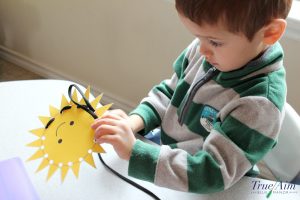How Reading Aloud Will Change Your Homeschool

It wasn’t until my 4th child was born that I realized the importance of reading aloud.
He was my NICU baby, my preemie. I knew that he might have some developmental delays so I researched to find what I could do for him. With 4 kids under 6, I didn’t have a lot of time and I couldn’t afford to spend a lot of money.
You might think it’s just too simple of an answer. It’s true that reading aloud is almost free. It takes little time and no special training, but sometimes the most effective learning tools are the simple ones.
Sometimes it is the more complicated, expensive, and flashy tools that are the most ineffective. In fact, they can hinder learning!
The Benefits of Reading Aloud in Your Homeschool
A lot of homeschooling parents put reading aloud at the bottom of the list. Sometimes we dismiss storytime with our children because of the different ages we are teaching, like older children can’t appreciate a good picture book.
Maybe we buy a curriculum and we feel the need to finish it simply because we spent the money. So after we have finished with all the lessons, we are tired, the house is messy, and reading aloud takes a back burner to our more formal lesson plans. However, research shows, reading aloud is the first thing we should be doing to make our children better readers, better writers, better listeners, and better citizens.
Reading is the basis for learning. Everytime we read aloud, we feed our children the sounds that they need to be able to read words. Everytime we read aloud we are unintentionally giving our children a grammar lesson. Everytime we read, we are building our children’s vocabulary. Everytime we read, we are building their attention span. More importantly, everytime we read and our children enjoy it, we are cultivating a love for books and learning in general.
You can Google all of the research done on reading, but I’ll just list a few here to give you an idea:
• Children who are read to have higher reading scores.1
• Children who are read to have higher writing scores.2
• Children who are read to have higher math scores.3
• Children who are read to have lower risks of substance abuse.4
• Children who are read to have lower chances of getting Alzheimer’s later in life.5
• Children who are NOT read to have higher rates of criminal activity.4
3 Tips for Reading Aloud in Your Homeschool
1) Don’t Expect Your Children to Sit for Hours
Don’t expect your children to be ready to sit for hours listening to Shakespeare. The goal is to get our kids to LOVE reading. It doesn’t have to be a painful experience. Start with 5-10 minutes a day and work your way up to longer periods of time.
2) Busy Hands Don’t Have to Be Still
During read-alouds, try giving children a quiet activity like coloring, puzzles, or stickers while you read.
3) Enlist Older Children
Enlist older children to read to younger kids and reward them appropriately! Don’t have older kids? Try enlisting a neighbor or family member. You can even use FaceTime or Skype if you don’t have anyone nearby.
For more ideas and facts on reading aloud, join my Free Class and you’ll be itching to read any chance you get!

Our Favorite Read-Aloud Books!
I was doubtful that my 3-year-old old son would like the Beatrix Potter book that he came to me with for story time one night. He always chose the non-fiction books with the lists of things to point at and say what they are called. Guess what? He sat through the whole thing and he wanted me to read it the next night too!
Sometimes a child has to be warmed up to books before they are ready to sit down and read it with you. Introduce a new story by putting it out where your child can flip through it and experience it himself before you read.
Here are a few of our favorite read-aloud books for all ages!
Picture Book Favorites
• Farmyard Tales by Heather Amery, illustrated by Steven Cartwright. A collection of simple stories about the farm, this book has many unique features that you don’t see in regular storybooks. There are simple sentences at the top for very young children that make the story shorter. Your early reader can practice by reading those simple sentences and you can read the more detailed text at the bottom to give them more substance about the story. There’s also a little duck hiding on every page that toddlers LOVE to find!
• The Monster at the End of this Book by Jon Stone, illustrated by Michael Smollin. Even elementary children will love this tale of Grover and how scared he is of the monster at the end of the book. You and your children will be laughing all the way through!
• The Berenstain Bears books by Jan Berenstain and Mike Berenstain. I’m sure you’ve heard of these before, but we just love the morals each one of these books has in it. From kindness to responsibility, there are lots of character traits you can help your children understand with these books.
• Duck at the Door by Jackie Urbanovic. If you haven’t read a book in this series, start with this one and you’ll be hooked! My kids love how the author gives the animal characters human personalities. This book shows how the people we love always have their faults, but they add so many wonderful things to our lives that we would miss those faults if those people were gone.
• The Tale of Benjamin Bunny by Beatrix Potter. This is our favorite of her stories, but all are wonderful. We have a collection of 4 little books that are easy for little hands to hold.
• Stephen Cosgrove books. They’re a little hard to find, but all his books are wonderful because they have good values woven in each story. He has an early reader fictional series that follows one main animal character and his topsy-turvy books include two stories in one book with a magical land of bugs that touches on issues like vanity, friendship, and more! It’s fantastic!

Chapter Book Favorites
• Fizz and the Police Dog Tryouts by Lesley Gibbes. This is a great underdog story about a cute little white dog that wants to be a police dog, but he is too small and not scary enough. He wants to do something great in his community and a police dog is what he thinks would make a big impact. I just love the positive and realistic message this series portrays. It’s a beginner chapter book that you could read to your child when they are young and then bring it back out when they can read on their own.
• Imagination Station by Paul McCusker and Marianne Hering. Children learn history through this fictional series based on the Adventures in Odyssey radio show. My kids like how they are familiar with a lot of the characters from the show.
• Chronicles of Narnia by C. S. Lewis. I encourage you to read the stories to your children before they see the movie. It is SO much better to read them first. Your children will thank you for it.
• All Creatures Great and Small by James Herriot. This book is a memoir of a Scottish veterinarian who brings a whole new life to the world of animal medicine. I never knew how exciting his boring looking book could be, but my mother and I took turns reading it to each other when I was 12 or 13 and I remember how much I loved all the stories of the
animals and their owners. There are some graphic descriptions of procedures so you might want to wait until the children are older for this one.
• The Wizard of Oz by L. Frank Baum. This is another book to read to your kids before they see the movie. My children were begging for more after each session. It isn’t too scary, but has some suspenseful moments to keep younger children engaged.
• Little Women by Louisa May Alcott. The movie ruined the book because there are so many powerful messages that this book has that the movie cannot portray. I just love how the book shows the attributes of each young girl, the good and the bad. The language is a little more advanced but the story really paints a vivid picture of the family and mature lessons each girl learns.
I hope this encourages you not just to read more, but to read more GOOD books! It’s such a powerful learning tool that you shouldn’t underestimate.
About the Author
Janine LaTulippe is the mother of 6 blessings. She believes that an elite education begins in the home. Her sites www.BlueManorEducation.com and www.TrueAimEducation.com provide curriculum, free resources, and inspiration for homeschoolers!

References
• 1Educational Testing Service, 1999. America’s Smallest School: The Family.
• 2U.S. Department of Education. 1996. Reading Literacy in the United States: Findings From the IEA Reading Literacy Study.
• 3Raikes, H., Pan, B.A., Luze, G.J., Tamis-LeMonda, C.S.,Brooks-Gunn, J., Constantine,J., Tarullo, L.B., Raikes, H.A., Rodriguez, E. (2006). “Mother-child book reading in low-income families: Correlates and outcomes during the first three years of life.” Child Development, 77(4).
• 4National Information Center for Children and Youth with Disabilities. (1998). Children with reading disability. Washington, D.C.: Robert Bock.
• 5, , , , and
Homeschooling 101 eBook
No one knows your child better than you. We trust parents, and we want you to have the confidence to make the right decision for your situation.
We have compiled this eBook to help you through your decision. You’ll learn:
- The History of homeschooling
- How to find your state’s homeschool laws
- The different styles of homeschooling
- Tips from both professionals and veterans
- Where to find practical and inspirational resources to improve your homeschool experience
Enter your information below, and we will email the eBook to you right away.
[hubspot portal=”20645761″ id=”55f761b0-b799-40eb-8bc4-415cd73b2257″ type=”form”]